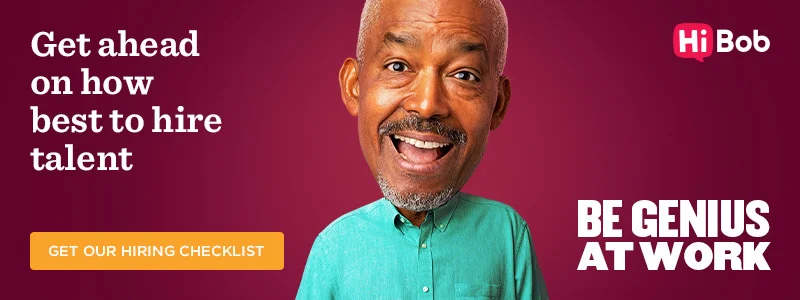It should come as no surprise that the hiring market is tough. It has gone through its ups, downs, and 180-degree changes, all while HR and TA teams try to keep up. While remaining flexible and agile amid these changes can seem impossible, these changes also bring opportunities and new ways for employers to gain an edge in the war for talent.
It’s an important edge, too, as the link between hiring and organizational success is crystal clear. People are your most important asset. Aside from the simple fact that they’re the ones who deliver on the strategy, the best hires also elevate performance, break new ground, and reshape a business in their own image.
In short, your future is at risk unless you find the solutions to your recruitment challenges.
The four big hiring challenges
As discussed, times change. But right now, there are four main recruiting challenges facing HR leaders, hiring teams, and, of course, all those hiring managers looking to recruit the very best talent.
1. Employee expectations
Research into US employment shows that Boomers now account for just 19 percent of the workforce. Gen X (35.5 percent) has now been overtaken by Millennials (39.4 percent), with Gen Z (30 percent) quickly appearing in everyone’s rear mirror. Effectively, employers must balance the needs of four generations with different expectations.
Among those expectations, the two biggest groups of employees want their employers to provide inspiration, connection, and a great working experience.
One key consideration here is that 80 percent of these workers expect to work hybrid or remote—so they get the right balance to be inspired in and out of work. Also, 74 percent of executives and senior managers are proactively investing in reskilling, helping their people to stay up-to-date with tech and evolve their careers.
It’s moves like this that give employees more confidence in their employer, which can triple their engagement at work and reduce the likelihood of someone searching for a new role by 69 percent.
2. Hiring processes
Traditional HR processes just don’t cut it anymore. CEOs feel recruiting is now the number four most inefficient business process behind emails, procurement, and meetings. Additionally, 60 percent of talent acquisition leaders think their main challenge is increasing hiring efficiency and reducing recruitment costs.
It’s not hard to understand why. Slow progress in the hiring cycle—from planning and posting roles on job boards to collating applications, interviewing, and offering—gives candidates a poor initial impression and the encouragement to look elsewhere. It’s a challenge made even more urgent when the best candidates are available for, on average, just 10 days.
<< Download our hiring checklist now >>
3. The local, regional, and global hiring landscape
When it comes to the hiring environment, there is some good news for employers. Seven in ten chief economists expect to see looser labor markets in the short term, particularly in advanced economies.
So, there should be a larger pool of talent to hire from. But this contrasts with the time it takes to hire. Experts predict it will take increasingly longer for HR teams to fill their roles—across every level of business. This suggests there are other pressures beyond supply and demand. As the needs of businesses shift in response to a changing market, HR and recruiting teams are struggling to keep up.
4. Technology
Lots of employers now use hiring software and other tech tools. Lots of which play a solid supporting role in recruiting. However, many of the pain points around hiring technology relate to the ROI of the tech itself. In fact, 88 percent of CEOs feel they don’t give value for money.
A big topic is integration. It’s important to look for ways to blend hiring data with other data streams, from simple spreadsheets to wider human capital management platforms that also support current employees. The insights can really drive strategy, yet this is a recognized problem: 50 percent of talent acquisition leaders either don’t have, or aren’t involved in, a workforce planning strategy.
Technology at the heart of the solution
One of our four challenges directly influences the other three: siloed and disconnected technology. Excitingly, it’s a challenge that is directly in an organization’s control. When employers don’t connect their ATS to other processes within their company, they fall into what we call the big four hiring traps.
Reactive hiring
In an ideal world, organizations proactively hire in alignment with a resource plan, preparing for vacancies before they ever happen. Reactive hiring, though, sees employers rushing to fill roles as they appear.
The first point here is the lead time between vacancy and hire. Without connecting proper planning to an ATS, hiring teams often need to go back and forth to get signoff on revised JDs and org charts—all while a team somewhere within your business is understaffed.
This means that when the hiring process does kick into gear, the process is instantly pressured. Stakeholders make snap decisions, which can result in a hire that isn’t quite right or may miss out on a better candidate because you run the ads for such a short time.
Over hiring
If you don’t know how many resources you need, there’s just as much chance you’ll over-resource as much as under-resource.
That can mean huge amounts of time and money wasted on advertising, interviews, offers, onboarding, and training. Only for the new recruits to find themselves twiddling their thumbs and leaving because they’re disillusioned or, worse, you have to finance a restructure. This can also compound performance in others, with the morale of those left hitting rock bottom and trust in leadership sorely tested.
Wrong-fit hiring
Going back to reactive hiring, the end result is often a wrong-fit hire who leaves within the first few months of starting. Beyond the financial hit of recruiting and training for the same role twice, there are other costs to consider here.
They may have a bad attitude that shakes a team’s ethics to its core—compounded by extra work they force their colleagues to shoulder during and after their time in the business. There’s a good chance their behavior will have a big impact on their manager, who will also lose faith in internal processes.
Depending on the role, customer relationships might be damaged. Additionally, once they’re out the door, a wrong-fit hire may leave a bad review of their brief employment, which makes it harder for you to attract good people further down the line.
Recommended For Further Reading
Long-cycle hiring
There are lots of reasons why a hiring process can take time. You may be carefully assessing candidates to make the right choice. There might simply be a lack of great candidates out there.
Equally, the problem might be that the process is too long or decision-makers can’t agree. Does a junior role really need three stages of interviews? Or are the hiring team’s ‘shortlists’ far too long?
Either way, it’s disappointing when a good candidate loses patience and accepts another offer. If you have to start from scratch, it will also hit the morale and productivity of the team you’re hiring for. Don’t forget, there’s also the external optics—candidates who get tired of waiting may write bad online reviews.
New challenges lead to new solutions
HR leaders and hiring teams have a challenging task ahead. The expectations of today’s employees call for many-a-rethink, and the continually evolving HR landscape complicates planning. Yet some challenges are eminently achievable even if, for some organizations, there might be long-standing issues around hiring processes and technology.
There has been a clear movement towards digital HR tools proven to get results, like using an ATS that connects to your HCM and other tech tools to improve hiring ROI. Those that use them won’t just win the battle for talent. They’ll secure their long-term future, too.

From Shelby Blitz
Shelby is the Director of Content at HiBob. She's passionate about the written word and storytelling. In a past life, she was a music journalist. When she's not writing and editing you can find her baking sweet treats in the kitchen.


